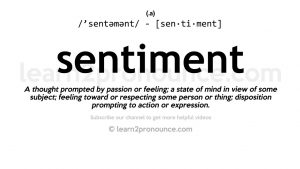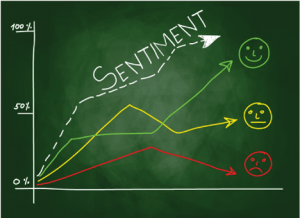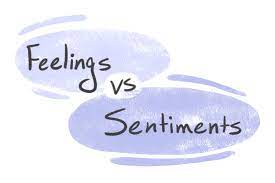In the intricate tapestry of human emotions, sentiments emerge as the colorful threads that weave together our experiences, perceptions, and interactions. At the core, sentiments represent the nuanced expressions of our feelings, opinions, and attitudes toward the world around us. As we delve into the multifaceted realm of sentiments, let’s unravel the various facets that define and shape our emotional landscape.
What Does Sentiments Exactly Mean?
The term “sentiments” encapsulates a broad spectrum of emotions, ranging from joy and love to sorrow and anger. It goes beyond a mere fleeting emotion, embodying a more sustained and complex state of being. In essence, sentiments are the deep-seated reflections of our inner world, influencing our perceptions and responses to external stimuli.
As Albert Einstein once eloquently put it, “The only source of knowledge is experience.” Sentiments, therefore, become the lens through which we interpret and understand the world, forging a connection between our personal experiences and the external reality.

Sentiments Meaning
To grasp the full meaning of sentiments, envision emotions as colors on an artist’s palette. Sentiments, then, become the paintings we create by blending these hues in unique and intricate ways. From the warm tones of happiness to the cool shades of melancholy, each sentiment contributes to the emotional masterpiece of our lives.
Maya Angelou’s words resonate powerfully in this context: “I’ve learned that people will forget what you said, people will forget what you did, but people will never forget how you made them feel.” Our sentiments, like indelible brushstrokes, leave lasting impressions on the canvas of our interactions.
Sentiments Synonym
While sentiments encapsulate a rich tapestry of emotions, various synonyms add subtle nuances to this emotional lexicon. Synonyms like “feelings,” “attitudes,” and “moods” each contribute distinct shades to the palette of human emotions. Just as a thesaurus expands our vocabulary, exploring sentiments through their synonyms deepens our understanding of the intricate dance of emotions.
In the words of Carl Jung, “The meeting of two personalities is like the contact of two chemical substances: if there is any reaction, both are transformed.” Synonyms for sentiments become the vocabulary through which we express, share, and understand the transformative reactions in our interpersonal alchemy.

Examples of Sentiments:
To comprehend sentiments fully, it is essential to explore concrete examples that exemplify the diverse range of human emotions. From the euphoria of a wedding day to the poignant sorrow of loss, these examples embody the richness and depth of sentiments.
In the realm of literature, Jane Austen beautifully captured the complexity of sentiments in her novel “Pride and Prejudice.” Elizabeth Bennet’s journey from initial prejudice to profound love illustrates the intricate interplay of sentiments, underscoring how emotions evolve and shape our narratives.
Sentiment in a Sentence:
In the succinct artistry of language, a well-crafted sentence can encapsulate the essence of sentiments. Consider the power of a sentence like “Her eyes reflected a mixture of joy and nostalgia as she revisited her childhood home.” In this sentence, sentiments are distilled into a vivid image, allowing readers to resonate with the character’s emotional landscape.
As Mark Twain aptly noted, “The difference between the almost right word and the right word is really a large matter. ‘Tis the difference between the lightning bug and the lightning.” Choosing the right words in a sentence ensures the illumination of sentiments in all their brilliance.
The Meaning of Expression of Sentiments: Articulating Inner Realities
Expression of sentiments encompasses the diverse ways in which individuals communicate their inner realities to the external world. Whether through verbal articulation, artistic creation, or non-verbal cues, the expression of sentiments becomes a profound act of self-revelation.
In the world of cinema, director Hayao Miyazaki masterfully employs animation to express sentiments. In films like “Spirited Away,” the visual language becomes a conduit for the characters’ unspoken emotions, transcending linguistic barriers and resonating with a global audience.
When someone declares, “Those are my sentiments,” they assert their personal perspectives, convictions, and emotional truths. This phrase encapsulates an individual’s commitment to their beliefs, values, and the unique lens through which they perceive the world.
As Eleanor Roosevelt wisely remarked, “Do what you feel in your heart to be right – for you’ll be criticized anyway. You’ll be damned if you do, and damned if you don’t.” Asserting one’s sentiments requires a willingness to stand firm in the face of scrutiny, embracing authenticity and individuality.

Does Sentiments Mean Feelings?
While sentiments and feelings are closely intertwined, they bear subtle distinctions. Feelings are often transient and immediate reactions to stimuli, whereas sentiments imply a more enduring and complex emotional state. In the mosaic of human emotions, feelings become the fleeting brushstrokes, while sentiments define the overarching masterpiece.
In the words of Antoine de Saint-Exupéry, “It is only with the heart that one can see rightly; what is essential is invisible to the eye.” Sentiments, rooted in the heart, allow us to perceive the invisible tapestry of emotional depth that colors our human experience.
How Do I Use My Sentiments Exactly?
Harnessing the power of sentiments demands a cultivated sense of emotional intelligence – the ability to recognize, understand, and manage one’s own emotions, as well as those of others. Utilizing sentiments effectively involves navigating the ebb and flow of emotions, making conscious choices, and fostering empathetic connections.
Daniel Goleman, a pioneer in emotional intelligence, once stated, “In a very real sense, we have two minds, one that thinks and one that feels.” The integration of thought and emotion allows individuals to use their sentiments as a compass, guiding them in decision-making, relationships, and personal growth.

What is the difference between emotion feeling and sentiment?
Distinguishing between emotion, feeling, and sentiment unveils the intricacies of the human experience. Emotions are the raw, instinctive reactions, while feelings represent the conscious awareness of those emotions. Sentiments, as the culmination of emotions and feelings, encapsulate the deeper, enduring aspects of our emotional landscape.
In the philosophy of Friedrich Nietzsche, “In every real man, a child is hidden that wants to play.” Emotions are the playground, feelings the conscious acknowledgment, and sentiments the essence that emerges from the interplay of these elements, enriching the human journey.
Conclusion: Sentiments as the Symphony of Human Experience
In conclusion, sentiments stand as the symphony that orchestrates the vast and intricate spectrum of human experience. From the ephemeral notes of daily interactions to the enduring melodies of personal narratives, sentiments infuse life with emotional depth and meaning.
To quote Victor Hugo, “Even the darkest night will end, and the sun will rise.” Sentiments, in all their diversity, remind us that each emotional experience contributes to the tapestry of our lives, creating a narrative that is uniquely ours. As we navigate the labyrinth of sentiments, may we embrace the richness, complexity, and beauty that emotions bestow upon the human spirit.
Наиболее стильные новости моды.
Исчерпывающие мероприятия всемирных подуимов.
Модные дома, торговые марки, haute couture.
Свежее место для модных хайпбистов.
https://stylecross.ru/read/2024-06-19-lacoste-kachestvennyy-premium-po-tsene-mass-marketa/